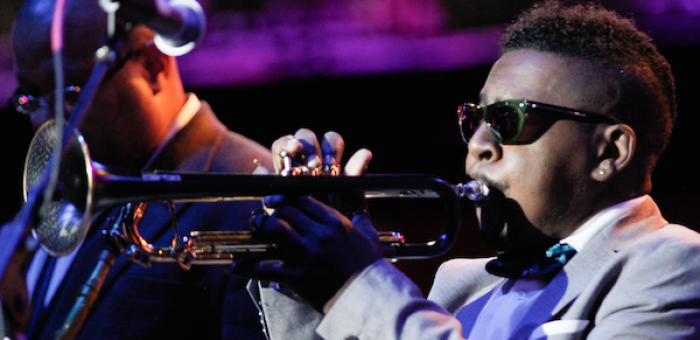Oct 28, 2025 10:47 AM
In Memoriam: Jack DeJohnette, 1942–2025
Jack DeJohnette, a bold and resourceful drummer and NEA Jazz Master who forged a unique vocabulary on the kit over his…

Roy Hargrove performs at the Detroit Jazz Festival on Sept. 3.
(Photo: Tony Graves)Due to a packed schedule in which one band follows another in rapid succession, it is sometimes impossible to conduct a sound check at DJF, and the Potter ensemble’s first number, “Firefly,” was interrupted by intermittent feedback and issues with the monitors and the mix.
Things settled down when the group addressed the four-part “Imaginary Cities” suite, an ambitious work in which Potter frames his force-of-nature tenor and soprano saxophone voices with well-integrated string writing, providing much room for Rogers, Nelson and Taborn to say their respective pieces, which they accomplished with brio.
I raced back to Wayne State Pyramid Stage to hear the last 20 minutes of a set by legendary bassist and 2016 DJF Artistic Director Ron Carter, who performed with pianist Renee Rosnes, drummer Payton Crossley and percussionist Rolando Morales-Matos. (Carter played Sept. 2 with his nonet; on Sept. 4 with his trio—guitarist Russell Malone and pianist Donald Vega—and on Sept. 5 with his big band.)
As I arrived, Rosnes was developing a two-part invention on “My Funny Valentine,” before darkening the texture and morphing into a blues conversation with Carter. The DownBeat Hall of Fame inductee had the audience in the palm of his hand, assuring them he would conclude the set with “something dedicated to each one of you.”
There ensued “You And The Night And The Music,” which Rosnes and Carter opened with contrapuntal lines before kicking into swing. The highlight was Carter’s elegant, almost jaunty solo, on which he eschewed quotation and enthusiastically dug into the task of finding new ways to create variations on the notes and tones, rendering rhythmic abstractions as the tempo ratcheted up.
Your correspondent dashed back to Carhartt for the evening’s final performance—a Gil Goldstein-arranged Roy Hargrove and Strings project (Hargrove also played the evening of Sept. 4 with the RH Factor). That the set had a disjointed quality was partially due to limited rehearsal time and the mixing problems that ensue without a sound check—the strings were positioned so as to make them seem in a completely different space than Hargrove’s quintet.
Still, Hargrove’s sui generis, voice-like tone—complemented by alto saxophonist Justin Robinson’s tart Bird-meets-Ornette refractions and pianist Sullivan Fortner’s off-kilter declamations—served off-the-beaten track “covers” like Ornette Coleman’s “The Blessing” and Herbie Hancock’s “Actual Proof,” as well as ballads like “I’m Glad There Is You” and the set-closing “You Go To My Head,” on which Hargrove veritably sang through his horn.

Jack DeJohnette boasted a musical resume that was as long as it was fearsome.
Oct 28, 2025 10:47 AM
Jack DeJohnette, a bold and resourceful drummer and NEA Jazz Master who forged a unique vocabulary on the kit over his…

D’Angelo achieved commercial and critical success experimenting with a fusion of jazz, funk, soul, R&B and hip-hop.
Oct 14, 2025 1:47 PM
D’Angelo, a Grammy-winning R&B and neo-soul singer, guitarist and pianist who exerted a profound influence on 21st…

To see the complete list of nominations for the 2026 Grammy Awards, go to grammy.com.
Nov 11, 2025 12:35 PM
The nominations for the 2026 Grammy Awards are in, with plenty to smile about for the worlds of jazz, blues and beyond.…

Jim McNeely’s singular body of work had a profound and lasting influence on many of today’s top jazz composers in the U.S. and in Europe.
Oct 7, 2025 3:40 PM
Pianist Jim McNeely, one of the most distinguished large ensemble jazz composers of his generation, died Sept. 26 at…

Drummond was cherished by generations of mainstream jazz listeners and bandleaders for his authoritative tonal presence, a defining quality of his style most apparent when he played his instrument unamplified.
Nov 4, 2025 11:39 AM
Ray Drummond, a first-call bassist who appeared on hundreds of albums as a sideman for some of the top names in jazz…






